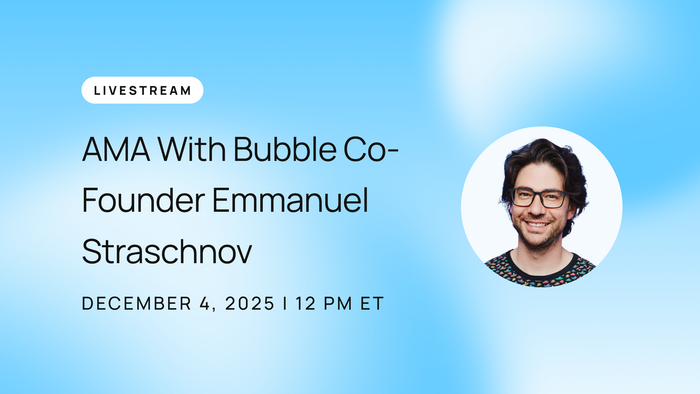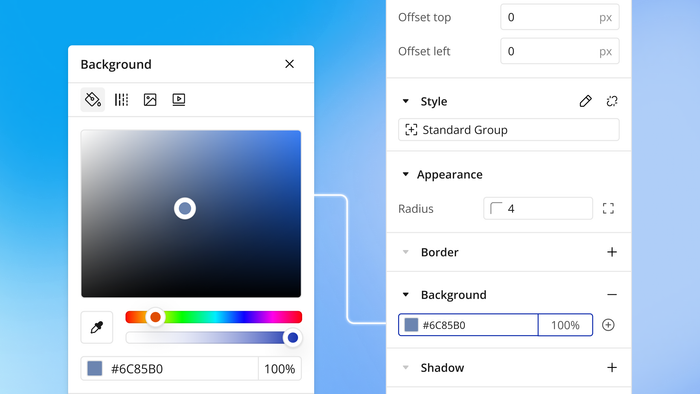Building in public has become a powerful way for founders and product teams to attract early users, build trust, and stay accountable. By sharing your process openly, you invite others into the journey and foster a community around your work.
At Bubble, we’re embracing this shift, too. We’ve started sharing more about how we build, where we’re headed, and what we’re learning from our community.
But building in public isn’t a one-size-fits-all strategy. It isn’t always easy. And it isn’t always wise to share everything. In this article, we’ll make the case for building in public, explain how to build in public (including what to share and best practices), and help you decide whether building in public is right for you.
What it means to build in public
Building in public is the deliberate choice to share the process of creating your product or service with the world. Founders and teams who build in public often share a mix of business progress, product updates, and personal reflections. That might include revenue milestones, launch updates, or behind-the-scenes insights into your decision making. But it can also mean sharing lessons learned and even the occasional struggle.
Done right, building in public can transform your startup journey into an interactive narrative that educates, inspires, and invites engagement.More than just a set of actions, it’s a philosophy.
In this article we’ll cover the benefits of building in public, what to share, and if it’s the right process for you.
Benefits of building in public
Building in public provides key strategic advantages. It’s especially powerful for early stage founders who need traction, validation, and connection before they have the resources to scale. Here are a few of the biggest benefits of building in public:
Growing your audience and building your brand
Building in public turns your everyday work into a means of engagement. Each product update, milestone, or insight becomes a reason for people to take notice. Over time, that consistent visibility builds recognition for both your product and your brand.
Sharing publicly also helps your ideas travel further. A thoughtful post can spark conversations, form new relationships, or lead to media coverage or speaking invites. By putting your process out there, you increase the chances of your work being seen, shared, and supported. Even thoughtful critiques of your product or process can be beneficial, creating new opportunities to articulate, clarify, or fine-tune your process.
Fostering community and loyalty
When people are invited into your process, they feel like they’re a part of the journey. That sense of inclusion builds emotional investment. Instead of being passive users, your audience becomes an active community that’s eager to support your work, contribute their own ideas, and stick around for the long haul.
And this community dynamic works both ways. Publicly sharing your goals or progress builds accountability, which can help keep you motivated and on track. Celebrating wins together makes them more meaningful, and public encouragement during setbacks can help you push through. Building in public is a way to build with others, not just for them.
Building trust and validating your product
Openly sharing both your struggles and successes signals honesty. It helps people see the effort behind your product, and the people behind your company. That authenticity fosters trust, which is especially important in the early stages when your product is still taking shape.
It can also accelerate your own learning process. Sharing early ideas and inviting feedback can reveal blind spots or misalignments before they become costly mistakes. Instead of guessing what people want, you’re including them from the start.
Attracting investors and teammates
Building in public shows how you think, how you work, and how you lead. That openness helps you attract like-minded people who are already in sync with your vision. Future collaborators, hires, and investors can follow your progress and decide if they want to be part of it.
By consistently showing up, you’re also building a track record. Your audience not only hears what you plan to do, but sees you follow through. That pattern of execution builds credibility and makes it easier for others to support your future efforts.
What to share when building in public
Building in public doesn’t mean sharing everything. The updates you make public should highlight your progress, thinking, and direction in ways that build trust, invite feedback, and create value for your audience.
Product updates and roadmaps
Regularly sharing product progress — like new features, bug fixes, and general improvements — keeps your audience engaged and informed. And public roadmaps encourage feedback and show users you’re actively working on what matters to them.
But be cautious with timelines. Sharing your overall direction is often better than committing to hard deadlines, especially if priorities are still evolving. And if your plans do change, be upfront about it. Users are more likely to respect a transparent shift than a quiet retreat from earlier commitments.
Behind-the-scenes culture and process
Giving people a look into how your team works (or how you work as a solo founder) helps humanize your brand. Sharing internal discussions, development workflows, design iterations, or even the way you structure your day-to-day operations creates transparency that feels real and relatable.
This kind of content doesn’t need to be flashy. A quick note about how you resolved a tricky decision or a screenshot of a messy whiteboard sketch can make your process feel accessible. It also helps others learn from your experience, which builds credibility and keeps your audience coming back.
Revenue milestones
Sharing revenue growth can be a strong signal of credibility, especially in the early stages. Simple updates like “$1K MRR → $5K MRR in 6 months” show traction and signal that you’re building something people are willing to pay for.
That being said, it’s often better to highlight trends and milestones than to share detailed financial breakdowns. Rounded numbers or percentage growth typically strike the right balance between transparency and strategic caution, especially as your company matures.
Responses to customer feedback
Building in public creates natural opportunities to share how user input shapes your product. Whether it’s a feature request, a bug report, or a surprising insight, sharing what you actually did in response to feedback demonstrates that you’re listening to customer needs and updating your product accordingly.
These don’t have to be major updates. A quick post about improving onboarding based on a support ticket, or tweaking a layout after a suggestion in your DMs, helps users feel seen and heard. This kind of responsiveness turns your audience into collaborators and reinforces the idea that they aren’t just watching your journey, but helping to shape it. It also encourages people to share more.
Founder perspective
Sharing your personal experience as a founder is often one of the most compelling parts of building in public. Offering a glimpse into your perspective helps personalize your brand, demonstrate how you think, and build affinity with both customers and industry peers.
Whether it’s a turning point, a tough lesson, or a small win, these reflections both humanize your journey and show how you lead. When people see how you navigate setbacks, shifts, and breakthroughs, it fosters connection and helps your voice stand out in a crowded space.
When not to build in public
Building in public is a powerful strategy — one we’re committed to here at Bubble. Sharing progress, insights, and lessons helps us connect with users and grow faster. But it isn’t always the right move in every situation. Here are a few cases where it may be better not to build in public.
When you’re working on something easily replicable
If your product could be cloned in a weekend, or if you’re relying on a clever integration, unique growth strategy, or unconventional positioning, it may be smart to keep some of those details private. Being first to market can offer a head start, but that edge fades quickly if others can replicate your idea just as fast. And if you give away what you’re doing before you launch, you might not even have that head start to begin with.
That doesn’t mean you can’t build in public at all. But you’ll need to be a lot more intentional about what you share. Focus on storytelling, progress, and lessons learned, while keeping the most sensitive mechanics behind the curtain.
When you’re scaling or attracting more competition
As your product gains traction, the balance between transparency and discretion starts to shift. In the early days, sharing raw metrics and internal decisions can build credibility and momentum. But as you scale, that same openness may start revealing too much to competitors. You don’t want to give away your secret sauce.
You might also find that the audience who once cheered your early wins no longer relates to your later-stage milestones. That doesn’t mean you need to stop sharing, but it may be time to refine what you share and why.
When you aren’t ready for the pressure
Building in public attracts attention and creates expectations you’ll need to manage. When things slow down or change direction, you may feel pressure to explain yourself, even while you’re still figuring it out. It also takes a lot of energy to share consistently and interact with your community along the way.
If that kind of visibility feels more like a burden than a motivator, it’s OK to keep things private. Not every stage of the journey needs to be shared in real time, especially during seasons of uncertainty, rest, or deep focus.
When public visibility could backfire
Not every moment is meant for the spotlight. If your team is navigating a sensitive transition, morale is shaky, or the product is in a rough patch, public updates may invite scrutiny that does more harm than good. Even well-meaning feedback can feel like pressure when confidence is low.
In times like these, it’s OK to protect your focus, your team, and your emotional resilience. You can always share later, once the story is clearer and the lessons are easier to articulate.
When your product or market favors discretion
Some products and industries simply aren’t a natural fit for complete transparency. If you’re operating in a highly regulated field, serving clients with strict confidentiality needs, or offering a product where security and reliability are critical, building in public may raise more concerns than it resolves.
These situations don’t mean you can’t be transparent at all, but you’ll need to be far more selective about what you share publicly. It requires greater care and attention to avoid breaching confidentiality, exposing sensitive information, or overstepping regulatory guidelines.
Best practices for building in public
How you go about building in public matters. These best practices will help you make the most of embracing transparency and engaging with your audience.
Define your goals upfront
Before you start posting updates, take a moment to clarify what you’re trying to achieve. Are you looking to grow your audience? Attract early users? Get feedback? Build investor trust? Your goals will shape what you share, how often you share it, and where you focus your energy.
Without this clarity, it’s easy to fall into the trap of sharing for the sake of sharing. But when your content serves a purpose, it becomes more valuable, both for you and your audience.
Choose the right platforms for your audience
Where you share matters just as much as what you share. Twitter/X is popular for real-time updates and community-building, while LinkedIn is great for longer reflections and B2B visibility. If you’re already using Substack, a changelog, or a company blog, those can be excellent starting points too.
The key is to meet your audience where they already are. Look for the platforms your target users actively engage with, and prioritize those — even if they aren’t your personal favorites. Effective sharing starts with showing up in the right places.
Start small and stay consistent
You don’t need to launch a full transparency dashboard or document every update. Start with something manageable, like a weekly recap, a product decision thread, or a behind-the-scenes blog post. Find a rhythm, see what resonates, and build a strategy you can maintain.
What matters most is showing up regularly. Consistency builds trust, and over time, your audience will come to expect and look forward to your updates.
Be strategic in what you share
Transparency builds trust, but that doesn’t mean sharing everything. The most effective builders in public are selective — open about progress, process, and lessons learned, but careful with sensitive information. Avoid posting anything that includes personal user data, security details, internal financial information, or proprietary product features.
It’s also smart to steer clear of internal team drama or negative commentary on competitors. If something could hurt your competitive edge, damage a relationship, or distract from your core message, it’s best not to make that public.
Engage with your community
Building in public means building relationships. When people respond to your posts, offer feedback, or ask questions, make the effort to reply. A quick “thank you,” a thoughtful follow-up, or even a repost can go a long way in showing that you’re paying attention.
These interactions help turn passive followers into active supporters. The connections you build through public engagement can become some of your most valuable users and collaborators.
Build in public — on Bubble
Before you can share your journey, you need the tools to start it. Bubble’s full-stack, no-code development platform makes it easy to build powerful, scalable apps — even with no prior experience. And Bubble AI lets you jumpstart the process by generating a personalized development blueprint and user interface.
Whether you’re testing an idea, launching your MVP, or expanding an existing product, Bubble gives you the tools you need to bring your vision to life.
If you’re ready to build in public, Bubble is where you begin. Start building for free →
Build for as long as you want on the Free plan. Only upgrade when you're ready to launch.
Join Bubble






